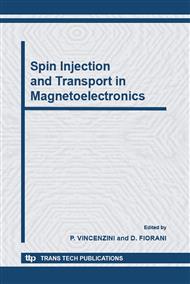[1]
S. A. Wolf., D. D. Awschalom, R. A. Buhrman, J. M. Daughton, S. von Moln'ar, M. L. Roukes, A. Y. Chtchelkanova, and D. M. Treger: Science vol. 294 (2001), p.1488.
DOI: 10.1126/science.1065389
Google Scholar
[2]
G. A. Prinz: Science vol. 282 (1998), p.1660.
Google Scholar
[3]
Y. Ohno, D. K. Young, B. Beschoten, F. Matsukura, H. Ohno, and D. D. Awschalom: Nature (London) vol. 402 (1999), p.790.
DOI: 10.1038/45509
Google Scholar
[4]
V. Dediu, M. Murgia, F.C. Matacotta, C. Taliani, S. Barbanera: Solide State Comun. Vol. 122 (2002), p.181.
DOI: 10.1016/s0038-1098(02)00090-x
Google Scholar
[5]
A. H. Davis, and K. Bussmann: J. Appl. Phys. Vol. 93 (2003), p.7358.
Google Scholar
[6]
E. Arisi, I. Bergenti, V. Dediu, M. A. Loi, M. Muccini, M. Murgia, G. Ruani, C. Taliani, and R. Zamboni: J. Appl. Phys. Vol. 93 (2003), p.7682.
DOI: 10.1063/1.1556118
Google Scholar
[7]
V. G. PROKHOROV, V. A. KOMASHKO AND V. L. SVETCHNIKOV, Y. P. LEE, K. H. CHO AND S. Y. PARK: J. Korean Phys. Soc. Vol. 45, (2004), p.22.
Google Scholar
[8]
M. Wohlgenannt, Z.V. Vardeny, J. Shi, T.L. Francis, X.M. Jiang, O. Mermer, G. Veeraraghavan, D. Wu and Z.H. Xiong: IEE Proc. -Circuits Devices Syst., vol. 152 (2005), p.385.
DOI: 10.1049/ip-cds:20045226
Google Scholar
[9]
I. Bergenti, V. Dediu, M. Murgia, A. Riminucci, G. Ruani, C. Taliani: Journal of Luminescence vol. 110 (2004), p.384.
DOI: 10.1016/j.jlumin.2004.08.036
Google Scholar
[10]
Z. H. Xiong, Di Wu, Z. Valy Vardeny, and Jing Shi: Nature vol. 427 (2004), p.821.
Google Scholar
[11]
M. Knobel, K. R. Pirota: J. Magn. Magn. Mater. Vol. 242 (2002), p.30.
Google Scholar
[12]
Se Hun KIM, Kyu Won LEE and Cheol Eui LEE: J. Korean Phys. Soc. vol 46 (2005), p.242.
Google Scholar
[13]
Byeong-Eog JUN, Chung-Sik KIM, Hyung-Kook KIM, Jung-Nam KIM and Yoon-Hwae HWANG, Dong-Jin KIM: J. Korean Phys. Soc. vol 46 (2005), p.44.
Google Scholar
[14]
M. N. Baibich, J. M. Broto A. Fert, F. Nguyen Van Dau, F. Petroff, P. Eitenne, G. Creuzet, A. Friederich, and J. Chazelas: Phys. Rev. Lett. Vol. 61 (1998), p.2472.
DOI: 10.1103/physrevlett.61.2472
Google Scholar
[15]
A. Yelon, D. Menard, M. Britel, and P. Ciureanu: Appl. Phys. Lett. Vol. 69 (1996), p.3084.
Google Scholar
[16]
Young Jong Lee, So-Jung Park, Andre J. Gesquiere, and Paul F. Barbara: Appl. Phys. Lett. Vol. 87 (2005), p.051906.
Google Scholar
[17]
Do-Hoon Hwang, Jong-Don Lee, Jong-Min Kang, Sangphil Lee, Chang-Hee Lee and Sung-Ho Jin: J. Mater. Chem. Vol. 13 (2003), p.1540.
Google Scholar
[18]
Sung-Ho Jin, Seung-Yun Kang, Mi-Yeon Kim, Yoon Ung Chan, Jin Young Kim, Kwanghee Lee, and Yeong-Soon Gal: Macromolecules vol. 36 (2003), p.3841.
Google Scholar
[19]
J. R. Macdonald, Impedance spectroscopy, (Wiley Interscience, New York, 1987).
Google Scholar


